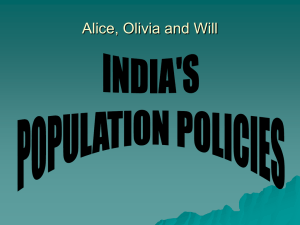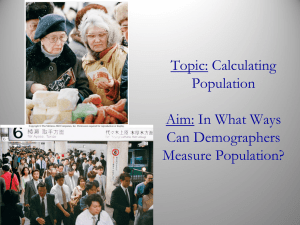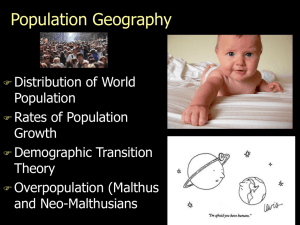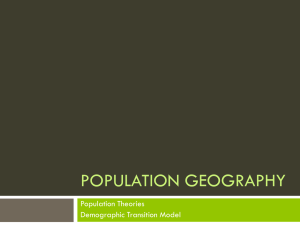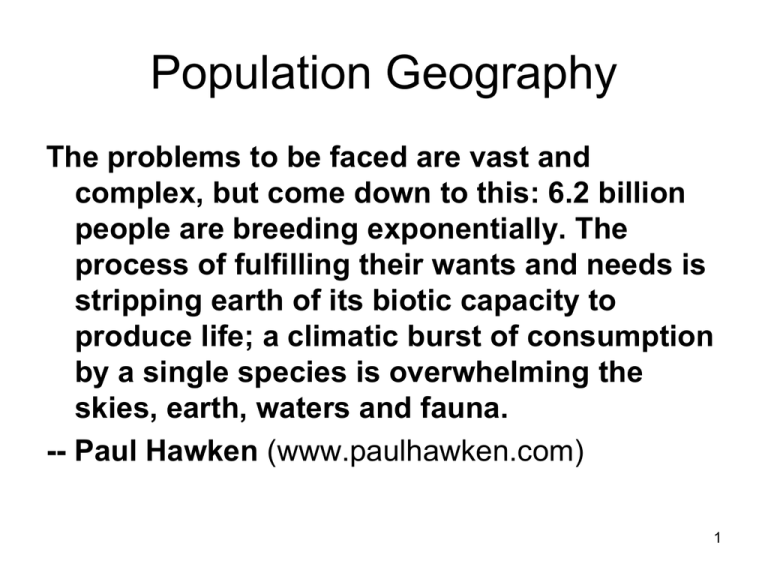
Population Geography
The problems to be faced are vast and
complex, but come down to this: 6.2 billion
people are breeding exponentially. The
process of fulfilling their wants and needs is
stripping earth of its biotic capacity to
produce life; a climatic burst of consumption
by a single species is overwhelming the
skies, earth, waters and fauna.
-- Paul Hawken (www.paulhawken.com)
1
Thailand as an Example
Can a country sharply reduce its population
growth in only 15 years?
– In 1971, Thailand adopted a policy to reduce
population growth.
2
Thailand (cont)
Several reasons account for this impressive feat:
1.
2.
3.
4.
5.
6.
7.
the creativity of the government-supported family planning
program
the high literacy rate among women (90%)
an increasing economic role for women and advances in women's
rights
better health care for mothers and children
the openness of the Thai people to new ideas
the willingness of the government to encourage and financially
support family planning and to work with the private nonprofit
Population and Community Development Association
(PCDA)(http://www.pda.or.th/eng/project_aids.htm)
support of family planning by the country's religious leaders (95%
of Thais are Buddhist)
3
How is Population Size Affected
by Birth and Death Rates?
Populations grow or decline through the
interplay of three factors:
• births
• deaths
• migration
4
Demographic Birth & Death Rates
• Crude Birth Rate (CBR) - the number of
live births per 1000 people in a population
in a given year.
• Crude Death Rate (CDR) - the number of
deaths per 1000 people in a population in
a given year.
5
Crude Birth Rates (CBR)
• annual number of live births per 1000
population.
• It is "crude" because it relates births to
total population without regard to the age
or sex composition of that population.
6
Crude Birth Rate (cont)
The crude birth rate of a country is
strongly influenced by;
• age structure of population
• sex structure of population
• customs & family size expectations
• adopted population policies
7
National crude birth rates vary
widely today
8
Lowering Crude Birth Rates
China's Way
• In 1965 Chairman Mao stated an ever
larger population was "a good thing," when
China's CBR was 37 per 1000 and its
population was 540 million.
• In 1976 population reached 852 million
although the CBR declined to 25.
9
China's Way (cont)
"One couple, one child" became the slogan
in 1979 backed by both incentives and
penalties.
• late marriages were encouraged
10
China's Way (cont)
Single child families received:
• free contraceptives
• cash awards
• abortions
• sterilization
11
China's Way (cont)
Penalties included:
• steep fines for second births
• sterilization of husband or wife of families
with more than one child
Penalties resulted in:
• Infanticide
12
China's Way (cont)
• Prosperous Urbanites
• Successful Population Controls
• Population Projections
13
China's Way (cont)
Falling fertility rates will result in:
• declining proportion of working-age people
• inadequate number of people to care for
rapidly growing number of senior citizens.
14
Factors Affecting Birth Rates
Religious
• Roman Catholics and Muslims
Political
• Italy
• European governments
15
Crude Death Rate (CDR)
• Crude Death Rate (CDR) - the number of
deaths per 1000 people in a population in
a given year.
16
Crude Birth/Death Rates
Developed vs. Developing World
17
Average Crude/Death Rates
18
World Birth/Death Rate Trend
• Birth rates and death rates are coming
down worldwide, but death rates have
fallen more sharply.
19
World Population Change
Rate expressed as a percentage:
Annual rate of
natural population
change (%)
=
Birth rate - Death rate
-------------------------------10
20
World Population Change (cont)
• Exponential growth
• World annual population growth rate
• Actual Population change
21
Annual World Population Growth
2002
22
World Population Growth Rates
1950 - 2050
23
Population Number by Country
• China (1.33 billion in 2010) and
• India (1.2 billion in 2011) make up 37% of
the world's population.
• US (312 million as of 12/7/2011) has the
world's third largest population but only
4.6% of the world's people.
24
Current &
Projected
Population
2004/2025
25
Total Fertility Rate (TFR)
• More refined that the crude birth rate.
• Shows the rate of reproduction among
fertile females 15 – 49 years old.
• CBR the denominator includes the entire
population including males and females
not of reproductive age.
26
Decline in
Total
Fertility
Rates
(TFRs)
27
World TFRs 2002
28
Population Projections
• UN population projections to 2050 vary
depending on the world's projected
average TFR.
• Next slide: UN population projections to
2050
29
UN Population Projections to 2050
30
Case Study: U.S. Fertility Rate
Changes
31
U.S. Birth Rates 1910 - 2002
32
U.S.
Population
Growth,
1900 - 2000
and Projected
to 2100.
33
Factors Affecting Birth Rates
and Fertility Rates
•
•
•
•
•
•
•
•
•
•
Importance of children as a part of the labor force.
Urbanization.
Cost of raising and educating children.
Educational and employment opportunities for women.
Infant mortality rate.
Average age at marriage
Availability of private and public pension systems.
Religious beliefs, traditions and cultural norms.
Availability of legal abortions.
Availability of reliable birth control methods.
34
Typical
Effectiveness
Rates of Birth
Control
Methods in
the U.S.
35
Typical Effectiveness Rates of
Birth Control Methods in the
U.S.
36
Typical
Effectiveness
Rates of Birth
Control
Methods in
the U.S.
37
What Factors Affect Death
Rates?
38
Demographic Transition
•
•
•
•
As countries become industrialized, first
their death rates and then their birth rates
decline in four steps:
Pre-Industrial Stage
Transitional Stage
Industrial Stage
Post-Industrial Stage
39
Indicators of Overall Health
• Two useful indicators of overall health of
people in a country or region are:
• life expectancy - the average number of
years a newborn infant can expect to live
• infant mortality rate - the number of
babies out of 1000 born who die before
their first birthday
40
Hans Rosling
• Swedish medical doctor, academic,
statistician and public speaker
• http://www.youtube.com/watch?v=jbkSRL
YSojo&feature=player_embedded
41
Demographic Transition
•
•
•
•
As countries become industrialized, first
their death rates and then their birth rates
decline in four steps:
Pre-Industrial Stage
Transitional Stage
Industrial Stage
Post-Industrial Stage
42
Distribution of HIV - 2001
43
World infant mortality rates in 2002.
44
2009 World Infant Mortality Rates
• 2.75/1000 births: Sweden
• 6.26/1000 births: U.S. (45th)
• 151/1000 births: Afghanistan (almost last)
45
Factors Keeping the Infant Mortality
Rate Higher than it Could Be
• inadequate health care for poor women
during pregnancy and for their babies after
birth
• drug addiction among pregnant women
• the high birth rate among teenagers
46
Age Structure Diagrams
47
Rapid Growth
48
Slow Growth
49
Zero Growth
50
Negative Growth
51
How Does Age Structure Affect
Population Growth?
• Any country with many people below 15
years old (represented by a wide based
population structure diagram) has a
powerful built-in momentum to increase its
population size unless death rates rise
sharply.
52
Population
Structure of the
Developed
Countries 2002
53
Population
Structure of
the
Developing
Countries 2002
54
Population Data for
The US, Brazil & Nigeria
55
How Can Age Structure
Diagrams Be Used To Make
Population and Economic
Projections?
56
Tracking the Baby Boom
Generation in the U.S.
57
Tracking the Baby Boom
Generation in the U.S. (cont)
58
Tracking the Baby Boom
Generation in the U.S. (cont)
59
Tracking the Baby Boom
Generation in the U.S. (cont)
60
Tracking the Baby Boom
Generation in the U.S. (cont)
61
Tracking the Baby Boom
Generation in the U.S. (cont)
62
Tracking the Baby Boom
Generation in the U.S. (cont)
63
Tracking the Baby Boom
Generation in the U.S. (cont)
64
Tracking the Baby Boom
Generation in the U.S. (cont)
65
Tracking the Baby Boom
Generation in the U.S. (cont)
66
Workers Supporting Beneficiaries
Social Security – 1945 - 2075
67
Baby Bust Generation
aka Generation X
• Jeff Gordinier is tired of being force-fed the
Beatles, the Summer of Love, Facebook and
Britney Spears. He says being heard over the
media din about boomers and their offspring,
Generation Y, or "millenials" as they're now
known, isn't just a challenge, it's annoying. Being
overlooked and underappreciated? It's neverending for him and his tribe of fellow Gen-Xers.
•
http://www.time.com/time/arts/article/0,8599,1731528,00.html?imw=Y
68
What Are Some Effects of Population
Decline from Reduced Fertility?
• Population geographers and health
officials project that the current HIV/AIDS
epidemic will claim more lives (mostly in
Africa and eventually in India and China)
in the early part of this century than WWII
did.
69
Solutions: Influencing
Population Size
•
•
•
•
How Is Population Size Affected by Migration?
Immigration in the United States
What Are the Pros and Cons of Reducing Births?
How Can Economic Development Help Reduce Birth
Rates?
• How Can Family Planning Help Reduce Birth and
Abortion Rates and Save Lives?
• How Can Empowering Women Help Reduce Birth
Rates?
• What Success Has China Had in Controlling Its
Population Growth?
70
How Is Population Size Affected
by Migration?
• The population of an area is affected by
movement of people into (immigration)
and out of (emigration) that area.
71
Immigration in the United States
• Between 1820 and 2000, the US has
admitted almost twice as many immigrants
and refugees as all other countries
combined.
72
Immigrants as Percent of U.S.
Population – 1820-2004
73
What Are the Pros and Cons of
Reducing Births?
• The projected increase of the human population
from 6.2 to 9.3 billion or more between 2002 and
2050 raises an important question:
Can the world provide an adequate standard
of living for 3.1 billion more people without
causing widespread environmental damage?
74
Question We Should Be Asking….
• What is the optimum sustainable
population of the earth based on the
planet's cultural carrying capacity?
75
Slowing Population Growth
Proponents of slowing population growth
contend that if we do not sharply lower
birth rates, we are deciding by default to:
• raise death rates for humans (already
occurring in parts of Africa)
• greatly increase environmental harm.
76
US Academy of Sciences and the
Royal Society of London
In 1992, for example, the US Academy of
Sciences and the Royal Society of London
issued the following joint statement:
• "If current predictions of population growth
and patterns of human activity on the planet
remain unchanged, science and technology
may not be able to prevent either irreversible
degradation of the environment or continued
poverty for much of the world."
77
How Can Economic Development
Help Reduce Birth Rates?
• Population geographers have examined
the birth and death rates of western
European countries that industrialized
during the 19th century.
• They developed a hypothesis of
population change known as the
demographic transition.
78


